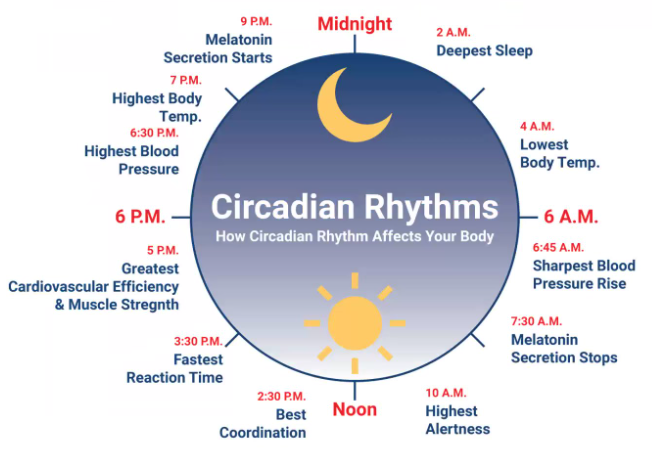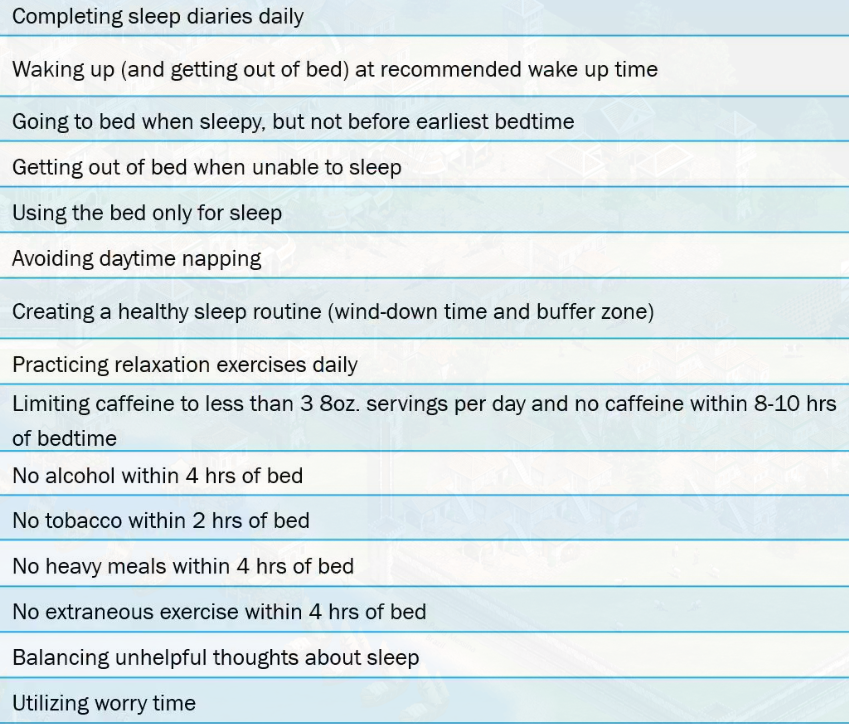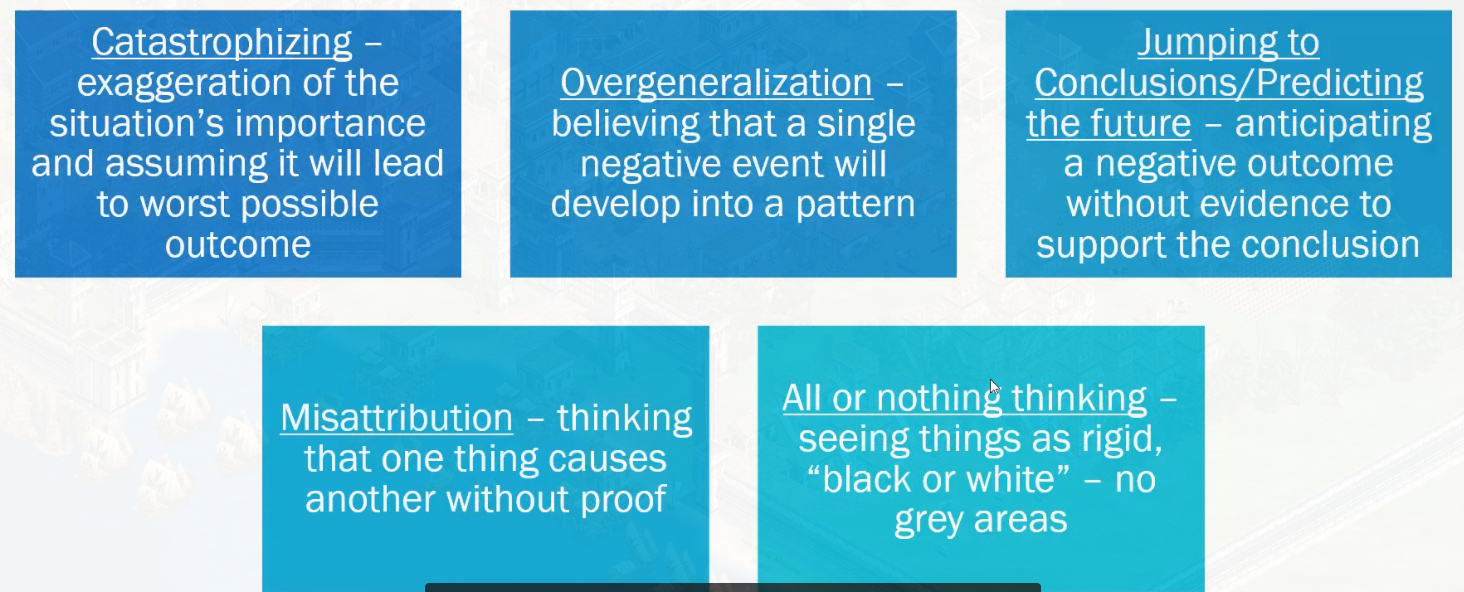Notes from Healthy Sleep (Insomnia CBT Class)
Intro
These notes from are from my insomnia counseling that I went to.
Details
SESSION 1: Purpose of Sleep
- Mood
- Memories
- Physical recovery
- Hormones
- Cognition
- REALLY: We don’t really know why, but we know it is needed
Insomnia: Disruptions of sleep that impact daytime function
- Difficulty falling and staying asleep
- Waking up too early
Sleep Cycles

Awakenings: 2-3 brief awakenings are natural/normal during sleep (9-10 micro-awakenings)
- N1: Fragile, transitionary stage of sleep (can easily be awakened)
- N2: Stronger sleep stage (only drastic noises or lighting)
- N3: [Deep sleep] Most restful – usually overhyped – frontend of sleep
- REM: Dreams, emotions, mood, energy, and memories – backend of sleep
Sleep
- Sleep drive: Builds over time of the day (don’t go to sleep early since it can cause insomnia) – usually 16 hrs but can be more
- naps are similar to “snacks” for sleep
- Circadian rhythm: Consistency
Sleep Hygiene

- Sleep environment: Noise, light, temperature
- Reduce caffeine: None within 10 hrs of bedtime (or in other words, none after noon)
- Avoid: Watching the clock, phones, or TV
- Avoid large meals, exercise, alcohol, and nicotine: Within 4 hrs of bedtime
Insomnia Coach (phone app: sleep diary)
- Within 2 hrs of wakeup and NOT in bed
- Perception of sleep is more accurate than smart devices
- Don’t use sleep recommendations – will make it manually in class
SESSION 2
Sleep Efficiency training: Goal of 85%
Sleep Window: total sleep + 30 min (e.g. 5.5 hrs asleep = 6 hrs in bed)
- Takes 2 weeks to re-acclimate
Slowly increase sleep window to increase total sleep time
Sleep Drive: 24 hrs - [TIME ASLEEP] +/- 30 mins
Wakeup time: anchor for sleep drive and circadian rhythm
Sleep Time: bedtime 0100 to wakeup 0730
7 Sleep Rules:
- I must get out of bed at [WAKEUP] time: 0730
- Go to bed when sleepy but not before [BEDTIME]: 0130
- Get up when you can’t sleep
- Use bed only for sleeping – BED IS ONLY FOR SLEEP (NOT BED IS PLACE TO BECOME SLEEPY)
- Avoid napping
- Create a wind-down routine before bed
- Don’t occupy mind/think in bed
SLEEPY: eyes heavy, head nodding
STAY AWAKE UNTIL EARLIEST BEDTIME: do something standing up, boring but not too engaging (nothing that increases/fluctuates body temperature)
SLEEP CHANGES TAKE: 10-14 days (first 7 days are “tantrum phase” to reconfigure pattern) to build consistency
SESSION 3
Conditioning: can have conditioned insomnia where laying in bed results in doing everything but sleeping (thinking, worrying, etc.) ** very difficult to break once conditioned: break pairing with everything and then re-pair for bed + sleep only
Stimulus Control and Conditioning:
- 30-60min BEFORE bed/sleep: slow and not too active activities
- In Bed
- BED: sleep only
- only go to bed when sleepy
- get out of bed if unable to sleep after 15-20mins, do something relaxing, return to bed when sleepy, common first 2-3weeks of re-conditioning
- 30-60min AFTER bed/sleep
SESSION 4

Bedtime: 0000-0730
- Try breathing/relaxation exercises during most restful time in order to train parasympathetic nervous system
- Worry time: if we don’t give ourselves the chance to worry before bedtime, then we will worry/think at bedtime
- Do worry time BEFORE Buffer/Winddown zone
- WORRY TIME is without: tech, music, distractions, anything stimulating
- –> do some journaling maybe; give it 10 min timeframe; then do relaxation afterwards; STOP after timer 10min goes off
- worry time isn’t meant to be productive!!
- give it a schedule – anchor it to something; after work in car, after lunctime, etc.
Cognitive Model
SITUATION/EXPERIENCE -> [AUTO] THOUGHT -> EMOTION -> BEHAVIOR occurance -> interpretation -> feeling -> action
FRAMING
How do you frame your bad sleep? GOAL is to not frame it so negatively – instead of “I’m so tired because i slept so well i won’t make it” turn that into “i’ve survived tired days before and i can do it again! i’m doing the best i can”
HOMEWORK
- note/jot down any negative thought about sleeping – how do I talk about it?
- 3 mins of nice steady breathing
- daily worry time
SESSION 5
stick to bedtime: 0000-0730
homework: 1-2 to improve on sleepwise from checklist
SESSION 6
- Keep improving sleep: track and strive for 85% efficiency (time asleep/time in bed)
- Move up sleep bedtime by +15min increments
- Sleep tracker only necessary when sleep improvement is desired
- Flexiblity (i.e. sleeping in): only when stable, do 1x/week, don’t over do it (e.g. just sleep in 1 hr) <– eliminate sleeping flexibility when disturbances start happening again
- Plateau: stablizing for 2+ weeks; maybe hitting natural limit; diet, stress, physical activity, change winddown nighttime activity
Action
Get better sleep!


